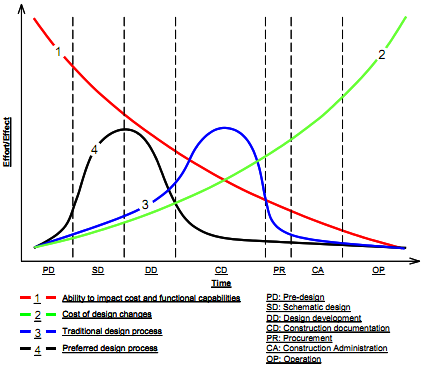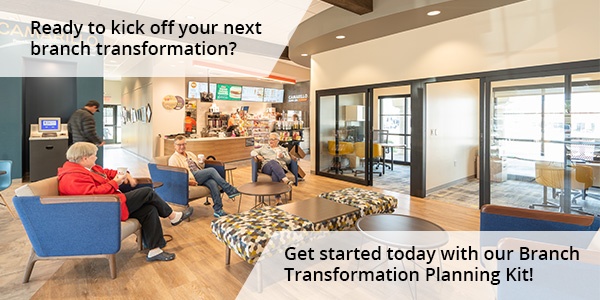We believe that collaboration, trust, and open communication are the foundation of a successful project. In the design-build project model, where partners and stakeholders are integrated into a project at the optimal time, sharing knowledge and ideas is fundamental. This model also builds a stronger sense of trust by shifting risk from the owner to the design-builder.
In our combined years of experience in project management, we’ve come to identify one factor that can reliably predict a project’s success more than any other: communication. A completed branch or workplace project represents the contributions and expertise from many people, and there is an ideal time to integrate each of them: where their input can have the greatest impact.
The challenge with the typical construction process, design-bid-build, is that planning, design, and construction happen in three discrete phases where partners in the design and build phases aren’t brought on board until the previous phase is complete. This raises a barrier between the design team, construction team, and the people who will actually be using the building, and this barrier creates missed opportunities where a participant could have made more impactful contributions had they weighed in on the project earlier.
This concept is best illustrated by the McCleamy Curve, seen in the chart below. At the beginning of a project it is easy and low-cost to make changes, but as the project progresses it becomes more difficult and costly to make design changes.

https://www.researchgate.net/figure/The-Macleamy-Curve-2004_fig3_266054953
The design-build process breaks down these barriers by bringing the design and build teams together under a single agreement, establishing a collaborative relationship between the designer, builder, and owner from the start of the project. Instead of focusing on individual pieces of work, the overall team focuses on a shared vision of project success. Every participant is brought on to contribute their best ideas at the right time, when they have the greatest chance of improving the project.
This dramatically pulls design changes to the front of the project, where the ability to impact the project is highest and the cost of design changes is lowest. Each design iteration is reviewed for cost and constructability by the construction team and loops back to the client for reviews, giving the team immediate feedback to how their decisions impact the budget and schedule. Having the construction team engaged in an iterative design process like this, with intimate knowledge of the cost of materials as well as the work needed to turn a design into reality, is a powerful tool for quickly developing designs that both fulfill the owner’s goals as well as their schedule and budget expectations.
Compare this to a design-bid-build project where a designer delivers a complete design which is then bid out for construction. If the bid is higher than the owner’s budget, or the availability of materials pushes the schedule out too far, the project has to go back to the drawing board for costly and time-consuming revisions. These late game changes extend the project’s schedule, and the owner is responsible for the cost.
The single agreement of a design-build contract shifts the cost risk of the project from the owner to the design-builder, who becomes responsible for the outcome of the project along with all work being performed. This gives the design-builder a strong incentive to represent the owner’s interest rather than just performing one piece of a larger project, and the trust this builds facilitates more open communication. Issues are more likely to be addressed immediately and change orders are rare.
Design-build eases the fits, starts, and frustrations that often come with complex building projects. When team members are collaborating actively, they can validate ideas, give immediate feedback, and hold each other accountable to the project vision along the way. The average design-build project costs less and is delivered faster, with a higher level of quality. Owners report better strategic outcomes such as increased productivity and customer satisfaction.
This blog is just one part of our “Learning the Process” series, which you can read here. We've released a whole series of articles covering aspects of our project management process. In many cases, the innovations we’ve discovered can carry over to the work you are doing and can help you build more robust project management processes on your own team.


